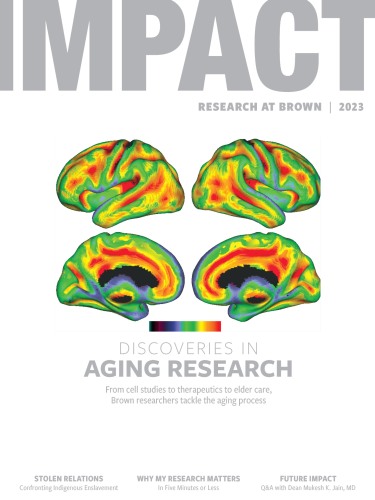Responsible Robotics
Choreographers and roboticists translate human movements into robotic code, and question the implications.
THE QUICK TAPPING OF TOES, a passé, the moonwalk—classic movements performed by human dancers are being emulated by robots, whose performances are showcased virtually to a global audience. Yet the same robots that jam to pop hits may be deployed for surveillance, police work, and war.
Robots’ evolving roles raise their profile and advertise their versatility to the mass public, but they also present questions involving ethics and the meaning of performance. Expert performers and engineers at Brown are sharing the stage to examine and teach this intersection of dance and robotics, known as choreorobotics, and explore its implications for the future.
Sydney Skybetter, deputy dean of the College, senior lecturer in theatre arts and performance studies (TAPS), and founder of the Conference for Research on Choreographic Interfaces (CRCI), and Stefanie Tellex, associate professor of computer science and engineering, have been in communication for years based on the overlap in their studies of motion, both human and robotic. They decided to teach these concepts together and worked with students to create the first course collaboration between the departments of TAPS and computer science: Choreorobotics 0101: Robotics and Choreography.
In the course, students studied robotics software, human choreography, and the history and implications of choreorobotics. “The interdisciplinary work we did showed me that it’s possible to combine these two fields,” said Navaiya Williams ’25.
The classroom training prepared students to work with Spot, a four-legged robot from Boston Dynamics. Williams and other students in the course programmed Spot to dance.
“ We get so excited about what we can build that we don’t think about whether we should. ”
Spot’s simple robotic movements were synchronized to music as a series of flowing motions: the extension of the legs forward as if in a crawl, elegant swoops of the robot’s long neck like a ballerina’s arms, and little steps on its rounded feet.
Researchers in this area investigate the optimal ways of translating the fluid transitions between human movements into robotic code. Choreographers bring an integral perspective on how best to interpret motion through technology, and computer scientists enable the technology to produce those movements.
Students are further exploring this research space beyond the choreorobotics course; for example, they worked with choreographer and CRCI artist-in-residence Yanira Castro to build and instruct a robot to perform with a güícharo, a traditional Puerto Rican musical instrument.
“As robotics gets applied to different fields, new subproblems appear that have never really been considered and act as a test bed or a research bed for developing new technologies that can be applied to other areas,” said Choreorobotics 0101 co-instructor Eric Rosen ’18, PhD’23, who also helped design the course.
Researchers are investigating how robots can communicate with people without words. Other questions involve how robots can be programmed to understand and respond to their surroundings more independently rather than being limited to concrete scripts of code.
The field also presents an ethical dilemma. Given the emotional, communicative essence of choreography and the historically utilitarian, function-first nature of robotics, “the logic applied to this field becomes very one-sided, either purely qualitative or purely quantitative” if choreographers and roboticists aren’t both involved, said Madeline Morningstar ’21, a consultant in emerging technologies and experience management and CRCI’s former director of curriculum. “We get so excited about what we can build that we don’t think about whether we should.”
Skybetter noted that artistic pursuits in choreorobotics can serve multiple purposes, sometimes in opposition to the creators’ intentions. Morningstar offered an example: programming robots to dance can serve as a test of their physical capability for police work, while the resulting entertainment helps robots appeal to the public.
“Robots’ proliferation into personal, social, and civic spheres will generate new ways of meaning-making and relationality,” said Skybetter. “Robots will increasingly be members of society on some emergent level.”
“To engage in this work without an expanded timescale is dangerous, though,” he continued. “This technology is cool, but there are people’s actual bodies on the line when robots are deployed in civic, domestic, policing, and martial contexts. I want our students to understand the dynamics between robots and people’s bodies as being real and tangible and with corporeal consequences.”
